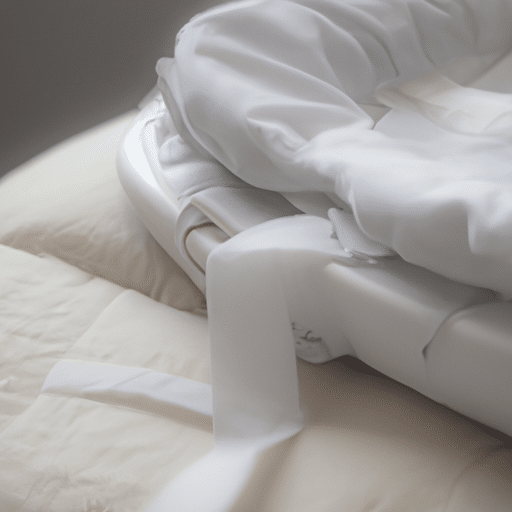Looking for the perfect changing pad for your little one? One of the most important considerations is whether to opt for a changing pad with safety straps or belts. While both options provide added security during diaper changes, it’s essential to weigh the pros and cons. In this article, we’ll guide you through the decision-making process, highlighting the benefits and potential drawbacks of each choice. By the end, you’ll have the confidence to choose the changing pad that best suits your needs and ensures your baby’s safety. So let’s get started!
Review contents
Overview of Changing Pads
Purpose of changing pads
Changing pads are essential items for parents and caregivers when it comes to ensuring the comfort and safety of their babies during diaper changes. The primary purpose of a changing pad is to provide a soft and hygienic surface for diaper changes, keeping the baby clean and comfortable. In addition to this, changing pads also serve to protect the surrounding area, such as the baby’s crib or bed, from any messy accidents that may occur during diaper changes.
Types of changing pads available
When it comes to changing pads, there are generally two types: those with safety straps and those with safety belts. Each type offers its own unique set of features and benefits, catering to the varying needs and preferences of parents. It is important to understand the differences between these two options in order to make an informed decision and choose the one that best suits your requirements.
Importance of safety features
One of the most crucial aspects to consider when choosing a changing pad is the presence of safety features. Safety straps and safety belts play a significant role in ensuring the well-being of your baby during diaper changes. These features are designed to provide added security and prevent accidents or injuries that can occur as a result of a baby’s movements during diaper changes. Understanding the function and benefits of safety straps and safety belts will help parents make a well-informed decision and choose the right option for their needs.
Understanding Safety Straps
Function of safety straps
Safety straps are designed to securely hold the baby in place while on the changing pad. They typically consist of adjustable straps that can be fastened around the baby’s waist and sometimes include additional straps for the legs. The main function of safety straps is to prevent the baby from rolling or falling off the changing pad, providing a secure and stable environment for diaper changes.
Benefits of using safety straps
Using safety straps during diaper changes offers several benefits that ensure the safety and comfort of both the baby and the caregiver. Firstly, safety straps provide peace of mind, knowing that the baby is securely fastened and cannot accidentally roll off the changing pad. This allows the caregiver to focus on the task at hand without worrying about the baby’s safety. Additionally, safety straps help to maintain a stable position for the baby, making diaper changes quicker and easier.
Factors to consider when using safety straps
While safety straps are beneficial, it is important to consider certain factors to ensure their effectiveness and safety. Firstly, it is crucial to adjust the straps properly to provide a snug fit without causing discomfort for the baby. Additionally, caregivers should always ensure that the baby’s head and neck are properly supported while using safety straps. Regular inspection and maintenance of the straps is also important to ensure that they are in good condition and functioning correctly.
Advantages of Safety Straps
Prevent accidents and falls
Safety straps are a reliable way to prevent accidents and falls during diaper changes. They provide a secure and stable environment, eliminating the risk of the baby rolling off the changing pad. This ensures the baby’s safety and minimizes the chances of any injuries occurring.
Secure positioning of the baby
By securely fastening the baby on the changing pad, safety straps ensure that the baby remains in a stable position. This allows the caregiver to have both hands free to change the diaper efficiently and effectively. The secure positioning of the baby also prevents any unnecessary movements that may make diaper changes more challenging.
Peace of mind for parents
Using safety straps on a changing pad offers parents peace of mind, knowing that their baby is safe and secure during every diaper change. This allows parents to focus on the task at hand without constantly worrying about the baby’s movements or the potential for accidents. The added sense of security provided by safety straps allows parents to complete diaper changes with confidence and ease.
Disadvantages of Safety Straps
Restricts movement of baby
One of the primary drawbacks of safety straps is that they restrict the movement of the baby during diaper changes. While this is essential for ensuring safety, it may cause some frustration or discomfort for the baby. Babies are naturally curious and may want to explore their surroundings during diaper changes, and safety straps can limit their ability to move freely.
Potential discomfort for the baby
If not properly adjusted or fitted, safety straps can cause discomfort for the baby. It is important for caregivers to ensure that the straps are snug enough to keep the baby secure, but not too tight to cause any discomfort or restrictions. Caregivers should also pay attention to the type of fabric or materials used in the straps to ensure they are soft and gentle against the baby’s skin.
Difficulty in cleaning
Another disadvantage of safety straps is the potential difficulty in cleaning them. Diaper changes can sometimes be messy, and the straps may become soiled with urine, feces, or other substances. Depending on the design and materials of the safety straps, they may be challenging to clean thoroughly. It is important to consider this aspect and choose a changing pad with easily removable and washable safety straps to maintain hygienic conditions.
Exploring Safety Belts
Function of safety belts
Safety belts, like safety straps, are designed to hold the baby securely in place during diaper changes. However, unlike safety straps, safety belts typically consist of a single strap that goes around the baby’s waist, securing them to the changing pad. Some safety belts may also include adjustable clips or buckles for added security.
Benefits of using safety belts
Using safety belts on a changing pad offers several benefits that make them a viable option for parents. Firstly, safety belts provide freedom of movement for the baby, allowing them to explore their surroundings to a certain extent. This can be particularly beneficial for older babies who are more active during diaper changes. Additionally, safety belts are often more convenient and easier to use than safety straps, making diaper changes quicker and more efficient.
Factors to consider when using safety belts
While safety belts offer their own advantages, it is important to consider certain factors to ensure their proper use and effectiveness. Caregivers should ensure that the safety belt is securely fastened around the baby’s waist, with no gaps that may allow the baby to slip through. It is crucial to regularly check the condition and integrity of the safety belt, as any signs of wear or damage may compromise its effectiveness.
Advantages of Safety Belts
Freedom of movement for the baby
One of the main advantages of safety belts is that they provide the baby with a certain degree of freedom of movement during diaper changes. This is particularly important for older babies who may be more active and curious. With safety belts, babies can wiggle their legs or move their arms more freely, giving them a sense of independence and allowing them to explore their surroundings to a limited extent.
Convenient and easy to use
Compared to safety straps, safety belts are often more convenient and easier to use. They typically consist of a single strap that can be quickly and easily secured around the baby’s waist. This simplicity makes diaper changes faster and more efficient, as caregivers do not have to spend time adjusting multiple straps or buckles.
Can be used for older babies
Safety belts are particularly suitable for older babies who are more active and mobile during diaper changes. As babies grow and develop, they become more curious about their surroundings. Safety belts allow older babies to move their limbs more freely, enabling them to explore their environment and feel a sense of independence during diaper changes.
Disadvantages of Safety Belts
Less secure than safety straps
One of the main disadvantages of safety belts is that they may be less secure than safety straps. Safety belts typically consist of a single strap, which may not provide the same level of stability and security as the multiple straps of safety straps. This increases the risk of the baby potentially rolling off the changing pad or causing accidents during diaper changes.
Increased risk of accidents
Due to the freedom of movement that safety belts provide, there is an increased risk of accidents during diaper changes. Babies who are more mobile and active may attempt to wiggle or crawl off the changing pad, especially if they are unattended for even a brief moment. Caregivers must exercise caution during diaper changes to prevent any accidents or injuries that may occur as a result of the increased mobility allowed by safety belts.
May not fit all changing pads
Another drawback of safety belts is that they may not fit all changing pads. Safety belts are often designed specifically for certain changing pads, and their compatibility may vary depending on the brand or model. It is essential for caregivers to ensure that the safety belt is compatible with the changing pad they have or consider purchasing a changing pad that includes a safety belt specifically designed for that model.
Choosing the Right Option for Your Needs
Considerations for your baby’s age and mobility
When choosing between safety straps and safety belts, it is important to consider your baby’s age and level of mobility. If you have an older baby who is more active during diaper changes, a safety belt may be a suitable option to provide them with a certain degree of freedom of movement. However, for younger or less mobile babies, safety straps may be more suitable to ensure their safety and prevent accidents.
Evaluate your personal preferences
Your personal preferences and priorities also play a significant role in deciding between safety straps and safety belts. Some parents may prioritize the security and stability provided by safety straps, while others may prefer the convenience and ease of use of safety belts. It is important to evaluate your own preferences and consider which option aligns best with your needs and priorities.
Assess the changing pad’s design
Lastly, it is crucial to assess the design of the changing pad itself when making this decision. Some changing pads are specifically designed to accommodate safety straps, while others may have built-in safety belts. Assessing the changing pad’s design will help you determine which option is compatible and suitable for your chosen changing pad.
Recommendations for Safe Changing Pad Use
Always supervise your baby during diaper changes
Regardless of whether you choose a changing pad with safety straps or safety belts, it is essential to always supervise your baby during diaper changes. This ensures their safety and allows you to act quickly in case the baby attempts to roll or crawl off the changing pad. Never leave your baby unattended on a changing pad, even for a moment.
Follow manufacturer’s instructions
To ensure the proper and safe use of your chosen changing pad, it is important to carefully follow the manufacturer’s instructions. This includes using the safety straps or safety belts as recommended, adjusting them properly for a secure fit, and regularly inspecting them for any signs of wear or damage.
Regularly inspect and maintain the changing pad
Regular inspection and maintenance of the changing pad is essential to ensure its safety and functionality. This includes checking the condition of the safety straps or safety belts, as well as cleaning and sanitizing the changing pad regularly to maintain hygienic conditions. Following a regular maintenance routine will help prolong the lifespan of the changing pad and ensure its continued safety for your baby.
Conclusion
When it comes to choosing a changing pad with safety features, both safety straps and safety belts offer their own advantages and disadvantages. Safety straps provide a secure and stable environment for diaper changes, preventing accidents and falls, while safety belts offer freedom of movement for older babies. Ultimately, the decision depends on your personal preferences, your baby’s age and mobility, and the design of the changing pad itself. By carefully considering these factors and following the recommended guidelines for safe changing pad use, you can create a comfortable and secure environment for your baby during every diaper change.






























